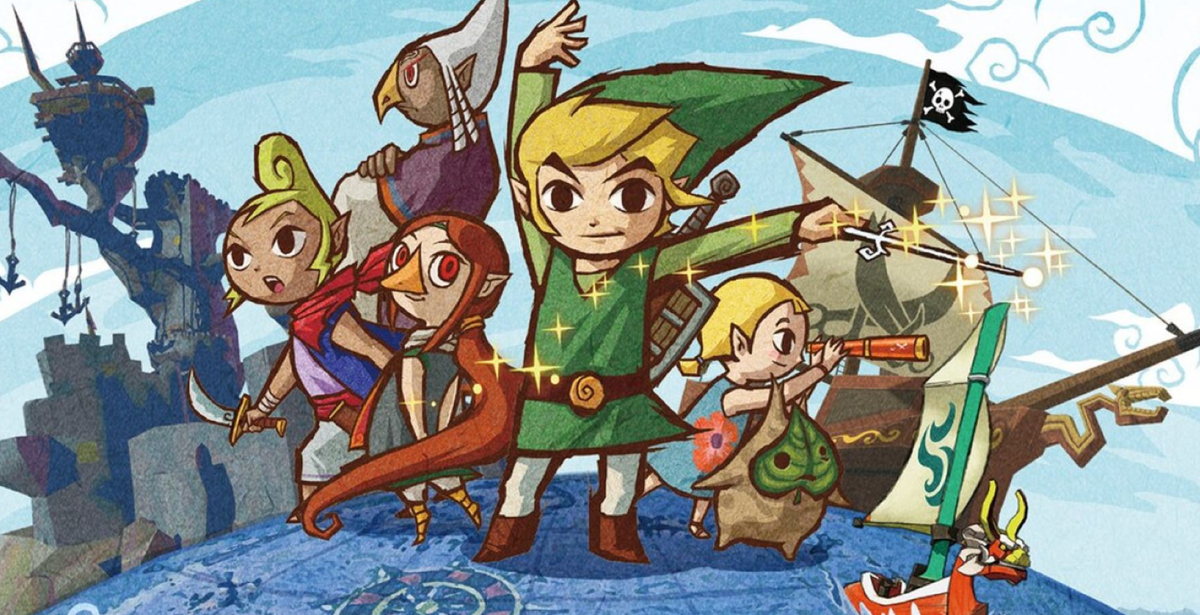
The Nintendo Gamecube – the little purple prism that could...or couldn't. While the system's middling performance was a rough patch for The Big N, many young gamers grew up cherishing its library of games. But do they hold up today? Join Anthony on his quest to find out as he reviews every classic title offered on Switch 2's Nintendo Classics service.
A tropical sun, accompanied by the gentle lap of ocean waves. Mandolin strings pluck to the beat of a steady drum, greeting a dragon-faced sailboat gliding upon the winds. The rattling of wood chimes summons the title “The Wind Waker” into existence as the camera pans over a humble island village, a pan flute melody heralding the arrival of a new legend. From the mountaintop, a boy gazes into the ocean horizon – discontent with the humdrum life of a boring island, yet knowing little of the destiny awaiting him.
It’s a ritual that greets us should we linger long enough on The Legend of Zelda: The Wind Waker’s title screen, the rich blues of sea and sky painting the scene with vibrant colors as young Link’s big, anime-esque cat eyes stare off into the shifting seas. This is not the realism depicted in Zelda’s N64 predecessors – it is unmistakably a cartoon, channeling Eastern designs to draw, ink, and animate Nintendo’s first feature animation.
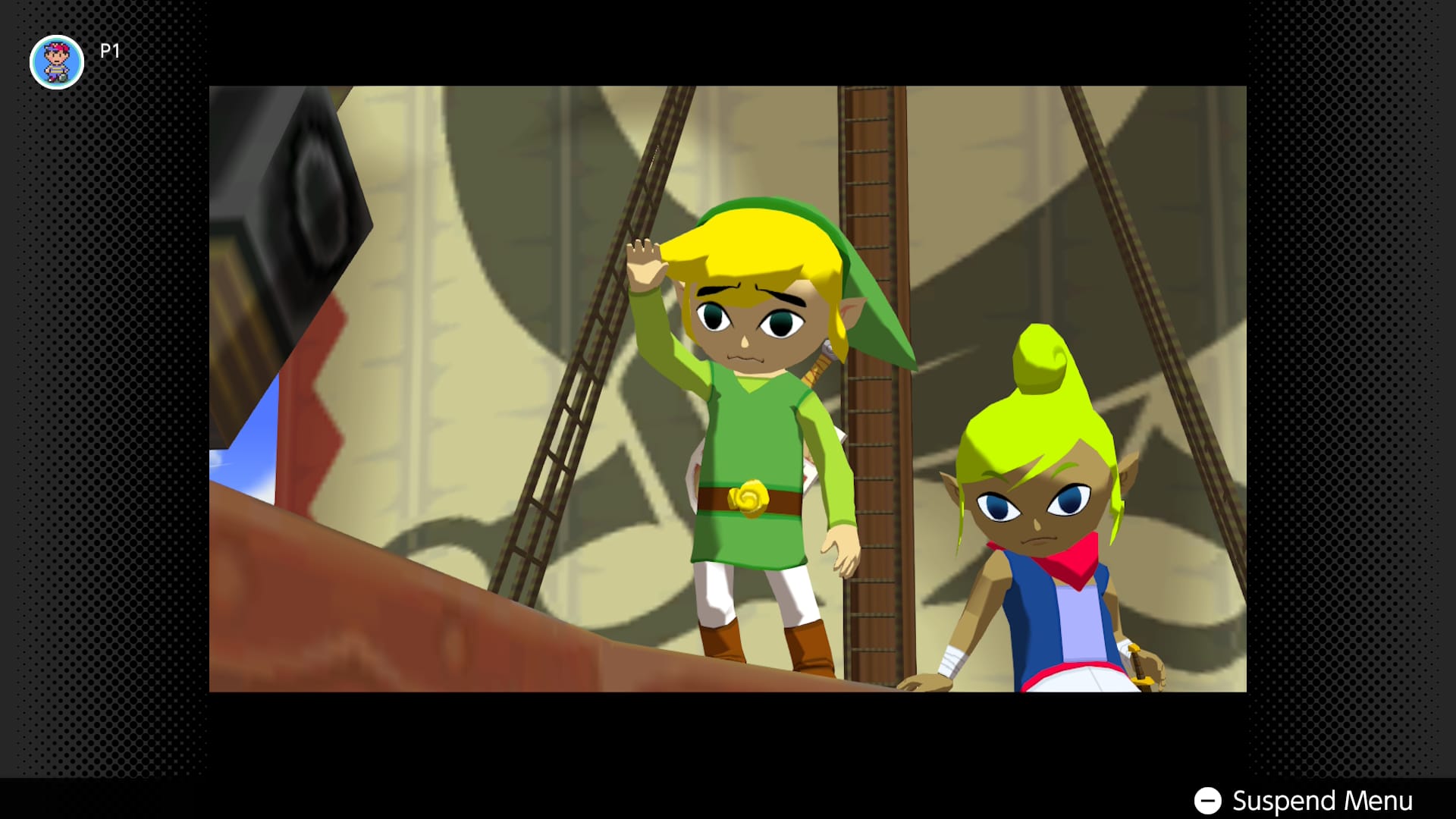
All thanks to the graphical wizardry known as cel-shading: a burgeoning artistic technique where clever use of shading, outlines, and solid color palettes is applied to computerized animation, mimicking the look of two-dimensional celluloids. Already breaking boundaries in feature animation, cel-shading’s use in gaming placed interactive cartoons in the hands of players, with the eye-catching likes of Jet Set Radio, Sly Cooper, and Viewtiful Joe the conduit for Saturday morning adventures that traditional hand-drawn animation could scarcely dream of. (Indeed, a Nintendo Dream interview had the interviewer opine that TV animation itself could soon be rendered obsolete – an ill-fated theory, but such was the technique's allure.)
Such deviance stood out in an age of rapidly-evolving tech, the arms race for bigger and better graphics encroaching upon the boundaries of polygons and reality. Yet, for better or worse, the Nintendo Gamecube was steadfast in its nonconformity, and whereas the likes of Metroid Prime and Super Smash Bros. Melee gleefully embraced lush biomes and detailed denim, Nintendo took The Legend of Zelda in a direction that shocked the industry: framing the fantasy series as a cel-shaded cartoon. This radical shift from an earlier tech demo – featuring a rousing display of realistic swordplay between hero Link and nemesis Ganondorf – had online message boards and comment sections furiously opining in all-caps tirades over this new Link: flat as Mickey Mouse himself, with his bobblehead cranium winking into the camera as he led hordes of goofy Moblins in a Scooby Doo-esque chase.
In an era where Nintendo faithful already had to fend off the pervasive conception of the developer being “too kiddy”, this new direction was bemoaned not merely as a confession, but as self-vandalism of their most hallowed franchise. Not-so-affectionally-dubbed “Celda” by both irked fans and media alike, the war over graphics was contested, argued and disputed up until launch – well into the market's rejection of Nintendo's purple lunchbox. Was The Wind Waker a damning sign of Nintendo's ignorance, or was it the call of edgy teens who thought themselves too old for fairy tales?
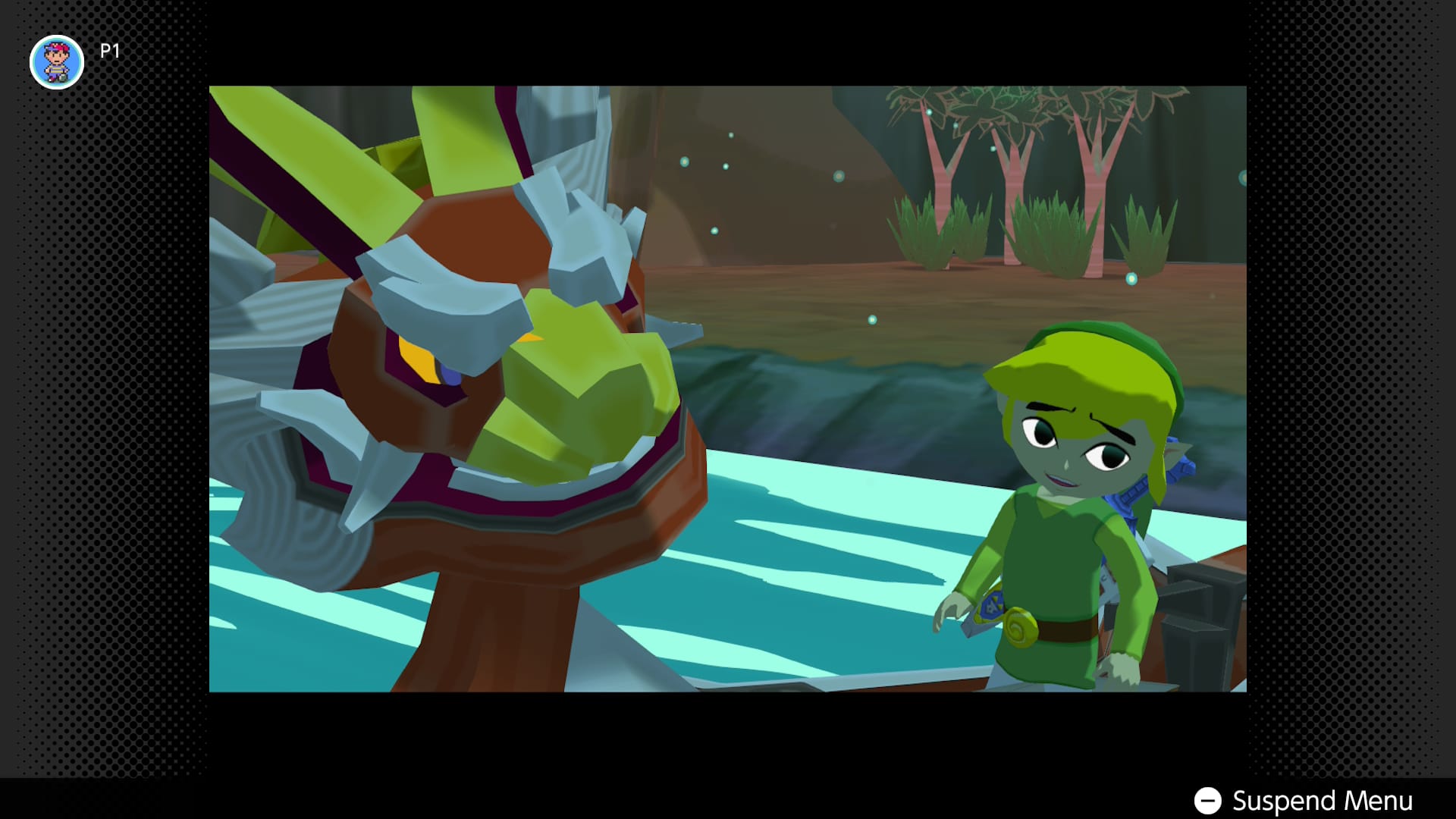
To eleven-year-old me, surely it must've been the latter, for nothing lit my imagination more than the coming-of-age hero’s journey within. The wide open Great Sea, populated with pirates, sea beasts, and treasure beyond one's wildest dreams. An ancient kingdom, magically preserved beneath the waves. The Tower of the Gods, lit aglow with holographic steps amidst its musty halls. The ethereal hum of the Wind Waker baton, its conducting of the winds accompanied by a holy hymn of bells and chants.
The Wind Waker was a fairy tale come to life, its abundance of adventure and personality transcending the realm of cartoon fiction into something real and felt, forging an unforgettable experience that marked me as a Zelda adherent for life. I was an ambassador driven to share its magic, be it the girl I liked to the impressionable 2nd grader across the street. Even the disc was otherworldly: coated with rough hieroglyphic textures emblazoned with the fictional Hylian language, it was like I was unearthing a sacred legend from the past; the Gamecube, its ancient apparatus, the only device capable of sharing this sacred tale for a curious, modern age.
From browsing fanfiction adaptions and sequels (and crafting tongue-in-cheek parodies of my own) to ardently defending the game’s merits on Nintendo’s official Nsider forums. From morning bus rides listening to the official soundtrack I’d bought off eBay to the perfect gaming backdrop that was Ocean City, Maryland’s seaside boardwalk. Joining the formative likes of Earthbound, Super Smash Bros. Melee, Super Mario 64 and Kirby Super Star, The Wind Waker had naturally inducted itself into my gaming hall of fame.
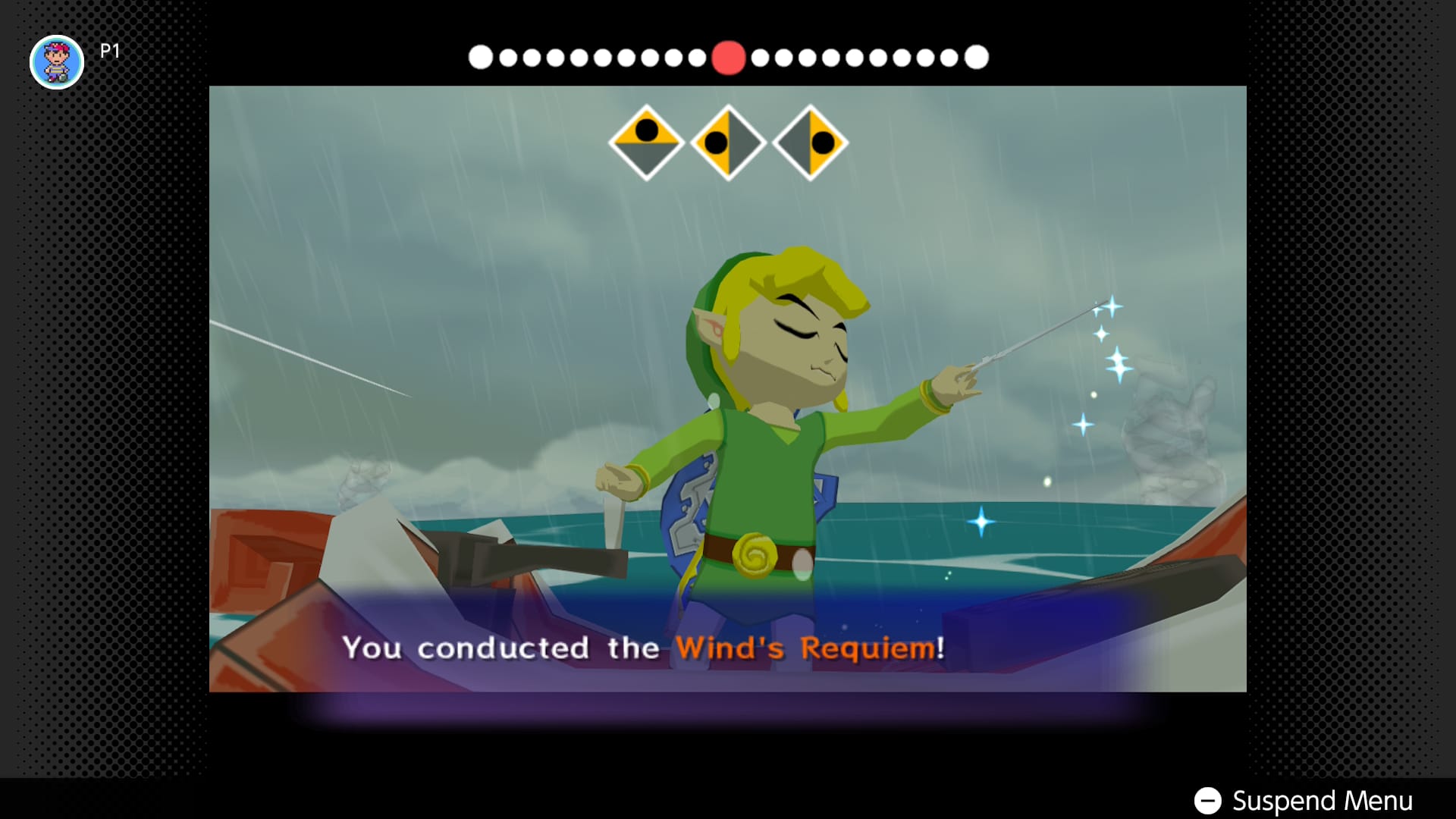
Alas, not everyone was enchanted by its stellar presentation – The Wind Waker endured heavy criticism since its 2003 release (or 2002, supposing you’d imported from or lived in Japan) in the area where it mattered most: gameplay. Indeed, the game is infamous for its cut corners, with whole dungeons and areas – perhaps even a whole overworld – cut in favor of padding courtesy of its gratuitous sailing. It was good, perhaps even great in spite of its shortcomings, but one ultimately failing to reach the lofty heights of the legendary The Legend of Zelda: Ocarina of Time – a consensus that stung all the more when considering The Wind Waker's sequel framing, with the newly-christened Hero of Winds picking up where the Hero of Time left off.
As a child, I defied the criticism thrown in The Wind Waker's way in gleeful ignorance, having loved it so much that I sailed through every sector to send off the game. Yet, as years have gone by, I've found even my own reverence has dwindled, my Zelda tastes drawn to the nebulous Majora's Mask and the pitch-perfect snappiness of A Link to the Past. It's a difficult reconciliation, recognizing that media and fiction that spoke to your formative years no longer has that same punch, their flaws disruptive and incongruent with the worship we so eagerly bestowed. Where does The Wind Waker land on the Zelda spectrum, really?
More than anything, The Wind Waker is a game reliant on vibes – the animated world is its most salient weapon, brimming to life with the rippling of the wind and the cries of gulls following your boat. It pulses with adventure and surprise, from cutting down roped bridges to monsters popping free from pots. Link’s expressive eyes gravitate to clues, guiding the player to puzzle solutions. Everything is alive.
Wind Waker's comedic anarchy remains unmatched. #Gamecube #WindWaker
— Anthony @ GamingTrend (MrSaturn99/Alagunder) (@anthonypsaturn.bsky.social) 2025-06-13T03:20:12.936Z
It’s a striking balance of realism and comedy – a juxtaposition all the more potent when considering The Wind Waker fully embraces its identity as a cartoon. From a little boy toddling after Link with goofy footsteps and a giant, exaggerated loogie dangling from his nose to cleverly sending a stone ceiling crashing down on the first boss, it is as much a high-fantasy adventure as it is a committed comedy. Just observe how it bleeds into the punchy combat: from endlessly pounding Moblins with your boomerang, sword slices mickey-mousing to the soundtrack, and smacking the chatty, ceaseless Miniblins like golfballs with the Skull Hammer, we're encouraged to stage anarchy straight out of Looney Tunes. (The bout of enemy friendly-fire above being a perfect showcase.)
As an aside, it’s why I’m sad the Tingle Tuner is unavailable for the Switch 2 release. For the uninitiated, it's the game's GameCube/Game Boy Advance connectivity feature where, via handheld, a second player operated a floating emblem representing everyone's favorite manchild Tingle, dispensing items, hints, and general mischief – not the least in interrupting Link's adventures by jubiliantly shouting “heyyyyyyyyyyy!” from a distance. Now, I'm not expecting the Switch 2 to emulate all that, but what's funny is that Tingle's brainchild's still mandatory to obtain. Really, it's as if the game's laughing in your face about it: "Haha, yeah, look at this gimmick from 2003 that you can’t play!" How cruel the limitations of technology can be.
And the way it balances all that irreverence with stunning fantasy! The Wind Waker bewitches everywhere you look, from the volcanic ash of Dragon Roost Island to the nightlight fireflies of the enchanted Forest Haven. The design ethos of children's pop-up books spring from its character designs, not the least in Great Fairies spun from spiral-cut paper. There is not a sight more beautiful on GameCube than the Fairy Fountains: sparkling grottos of azure, a never-ending blanket of sprites descending into the ether as the spell-binding hypnosis that is the classic Fairy Fountain theme binds us into reverie with its holy chorus.
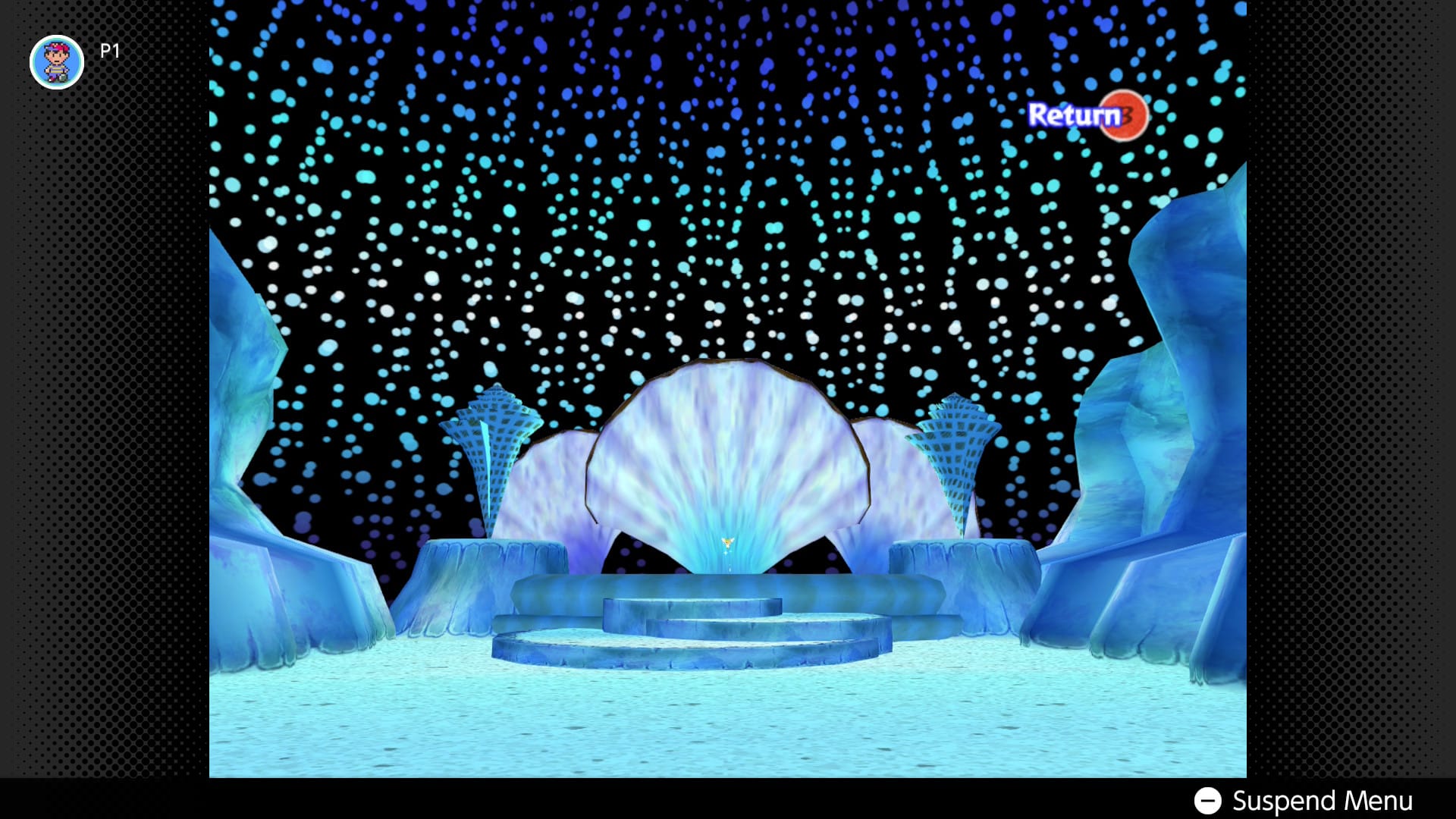
This is all buoyed by a lofty sense of scale: some have likened The Wind Waker to a proto-Breath of the Wild, and while it’s not quite open-world – you can’t just ignore the main quest, and the game gates you off from exploring – The Great Sea is a seamless map with looming landmarks and distant islands, all echoing the mantra of “You can go there." Link's diminutive size drives this point home: from the depths of cavernous dungeons to the thrill of towering beasts, the hero is but a speck overcoming endless seas and insurmountable odds, emulating the grandeur and scope of Disney's finest.
There’s a good deal of other compelling dressings. The soundtrack is an instant classic, be it the adventurous swell of The Great Sea, the infectious mini-boss theme, and the Celtic culture of Dragon Roost Island. “Toon Link”, as he’s come to be dubbed, remains the elven hero’s most charming iteration, his wildly fun library of emotions enduring as The Wind Waker’s strongest argument for its art direction. The final battle is a near-perfect symmetry of spectacle and theming, framing Zelda’s fated clash beyond the binary of good vs. evil. (My only gripe? It’s over far too soon.)
All this and more paint the picture of The Wind Waker being a timeless classic – but scratch beneath the oils, and the gameplay loop betrays that illusion. The often-derided sailing is the perfect example: to the patient sailor enchanted by The Great Sea, there is nothing more meditative as silently sailing into the night, interrupted only by the creaking of the King of Red Lions sailboat as you surf from island to island. (The Great Sea itself aids in this seduction with its deluge of never-ending blue paint, its gentle sifts and churns ready to spill outside the canvas that is your television screen.)
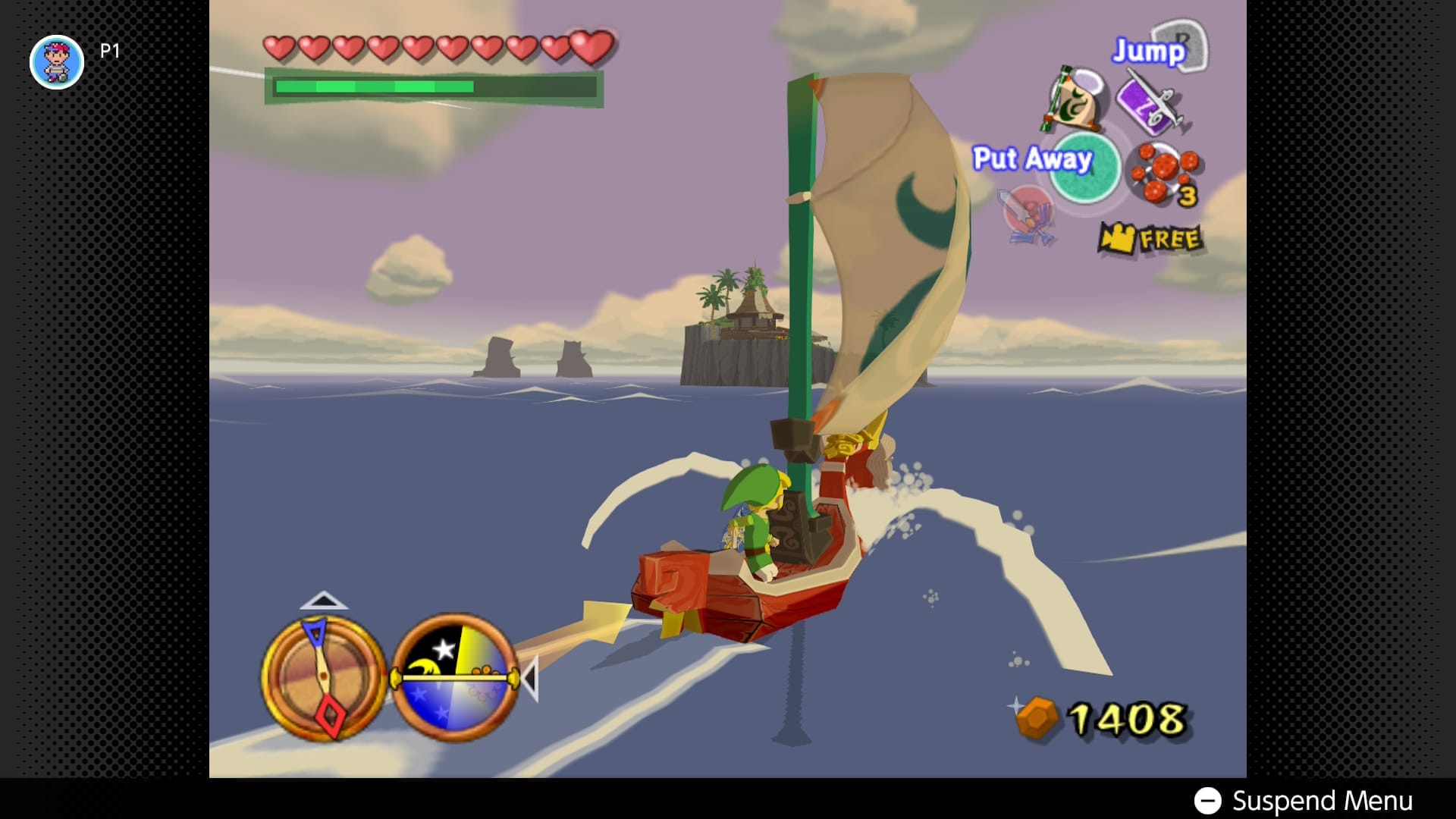
The problem, then, is that there is no push and pull. With horse-riding prior and afterward, you can’t just go full-spring across the fields of Hyrule – the stamina meter keeps the player in check, affixing Link and his trusty steed to a steady rhythm. There is no such engagement in Wind Waker’s boat; oh yes, there exist sea monsters and enemy warships lying in wait, but the moment-by-moment sailing does not engage, inviting protracted moments of nothing. Only the patient need apply. If that doesn’t work for you, the ocean is empty and sparse. The vibes are interesting; the lack of engagement is not.
This uneven dichotomy also rears itself in the dungeons: some of the most atmospheric spelunking in Zelda can be found here, from The Tower of the Gods’s breathtaking majesty to Earth Temple’s chilling morgues. Yet their linearity frequently falls back on the conventional “light the torches” and “push the blocks” puzzles so standard throughout the franchise, rendering them rudimentary exercises rather than mind-bending tests of courage. Only the Wind Temple succeeds in balancing both intrigue and operation, its grand currents and fans sailing Link up and away throughout its rusty, all-encompassing depths.
Combat, too, suffers from this unevenness: again, it presents a compelling foundation with whaling your sword away in glee. But not until the very end does it ever challenge: The Wind Waker is simply afraid to kill you, generous with healing handouts from fallen enemies – already too gentle with their weak blows. The parries are meant to test the player’s timing – and, to their credit, are pretty cool to watch – but frequently trivialize encounters to the point where it feels like cheating. The prospect of picking up enemy weapons is interesting, but they're little more than gimmicks: their limp, single swings disposable in the face of Link's rhythmic swordplay, let alone his arsenal of weapons and gadgets.
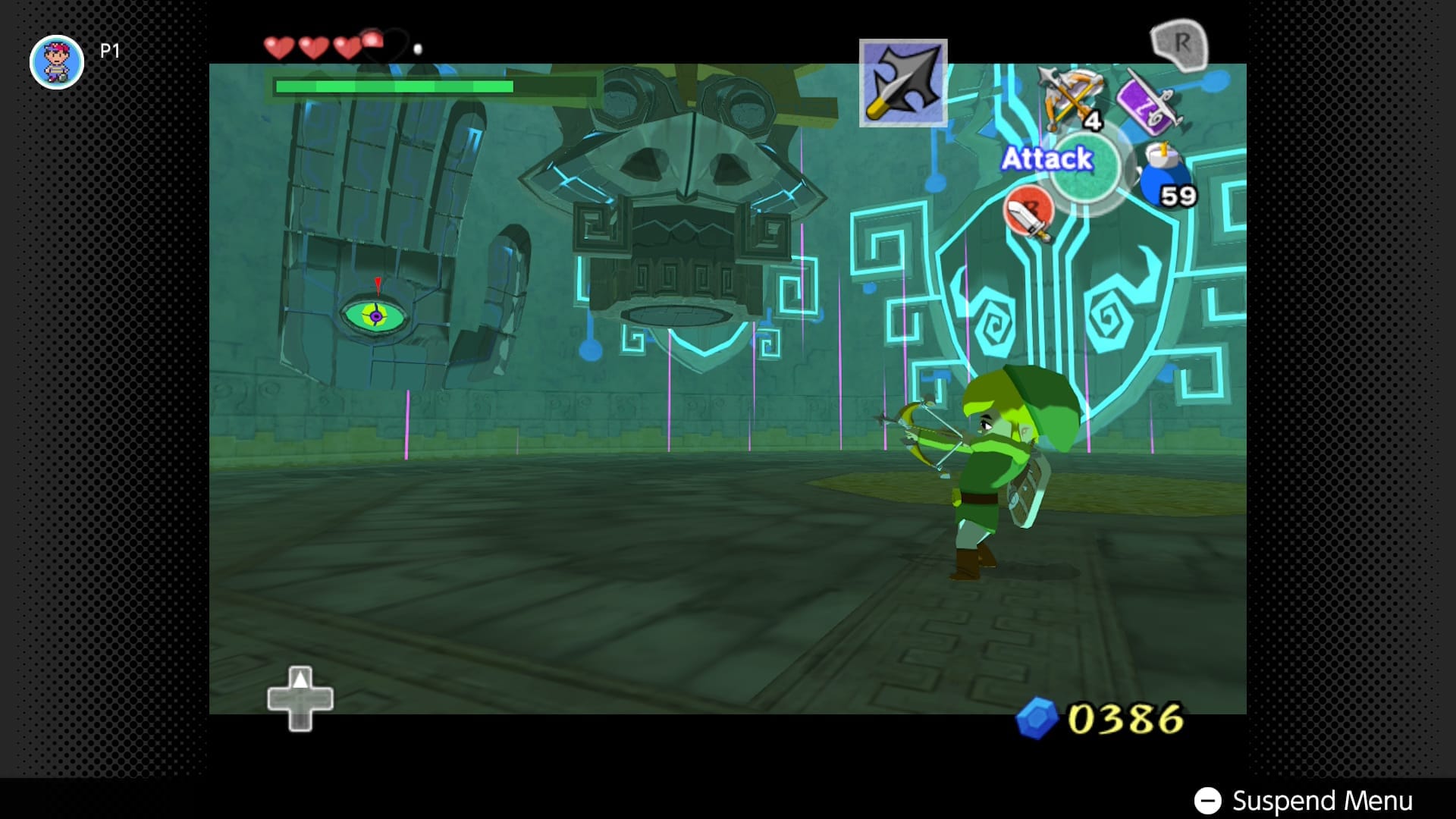
It's that last bit I want to touch upon – for all of The Wind Waker’s ambitions, it’s this gradual accumulation of half-baked concepts that frequently undermine this animated epic. The game is overly procedural, content with pulling from its same bag of tricks again and again. The haunted ghost ship is a natural inclusion in an aquatic setting, yet it's merely the latest in a long line of enemy routs. Ganon’s Tower is a middling endgame setpiece, recycling environments with the barest minimum effort rather than carving its own identity.
I hesitate to apply the “lazy developer” rhetoric – there are innumerable factors and pratfalls afflicting any game’s development, with The Wind Waker's problems lying squarely in its rushed development. Much like its contemporary Super Mario Sunshine, cut corners frequently impede The Wind Waker, namely to the tune of abrupt McGuffins. It’s irksome when the classic “find the three ____” assignment suddenly ends with the last pearl handed to you; it’s profoundly blatant padding to sunset Link’s quest by combing the seas for charts and Triforce pieces. Even 2013’s HD re-release can only paper over so much, its shortening of said hunt only highlighting how pointless and arbitrary it is.
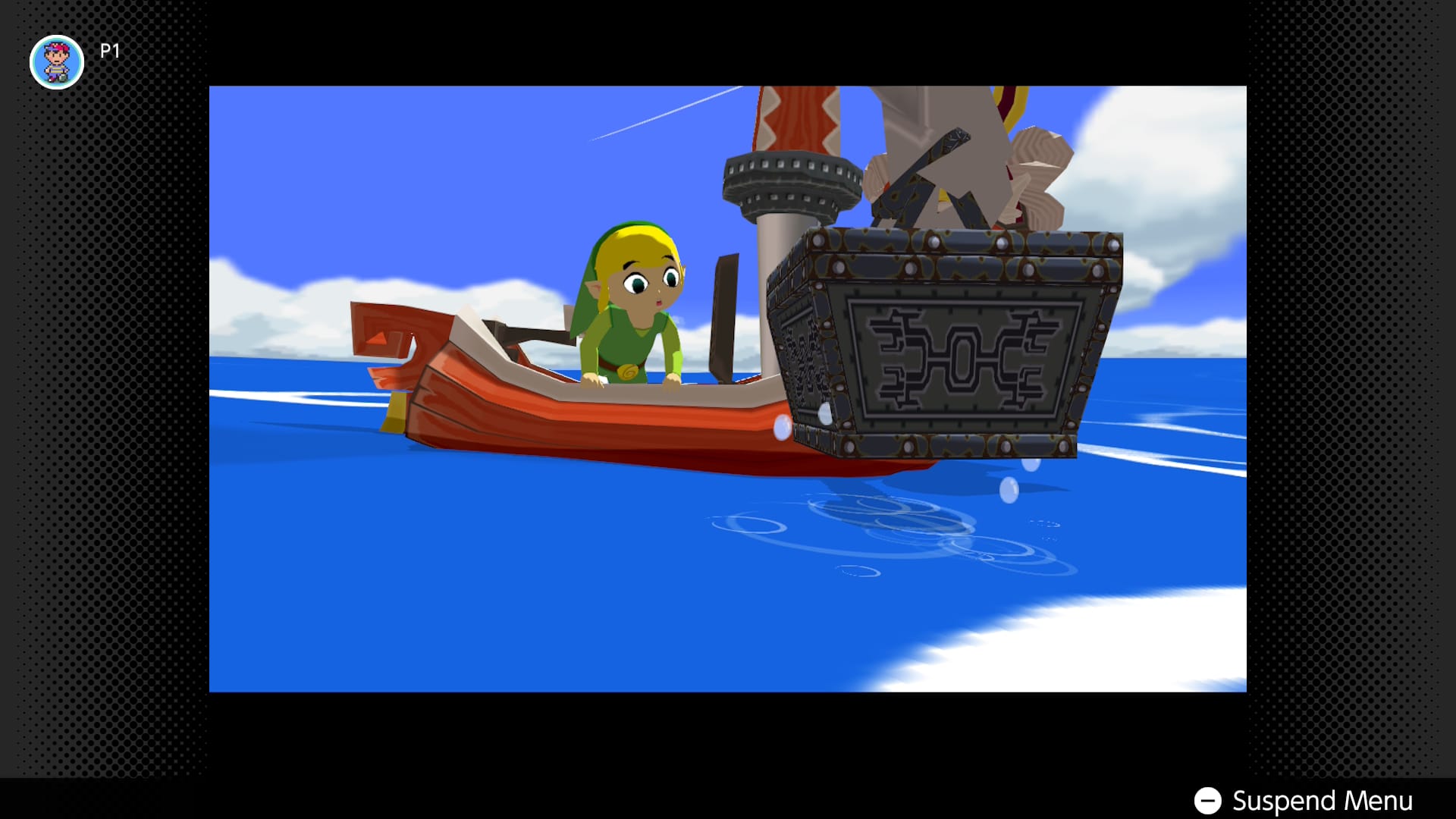
Revisiting The Wind Waker today, I am beset by waves of mixed emotions. The novelty of high-resolution cel-shading on a handheld does wonders for admiring its aesthetics. Not-so-gracefully uprezzed FMV sequences at the end – alongside the occasional visual glitch – form cracks in the emulation. As someone who’s completed the game innumerable times over the years, the reports of input lag, while noted, weren’t overtly felt (This isn’t to dismiss it, mind – we’ll dive into that problem more thoroughly in the next couple of columns). I smile and nod at the familiarity I've committed to memory, yet there's an offness I can't deny.
Proponents of the so-called “Zelda Cycle” – a lazy dismissal of series criticism, purporting an alleged shift to public opinion on Zelda games over time – have championed The Wind Waker as its representative, pointing to its timeless look over drab, flavorless iterations such as Twilight Princess. There's elements of truth here: the anger of the aughts has dissipated, with people having warmed to the divisive art style over time. And really, it does look nice: low-poly counts and animation glitches are easier to spot now, but that The Wind Waker was chosen as Zelda’s first HD uplift says it all: its confidence in artistic vision holds up even with the countless advances in gaming tech since.
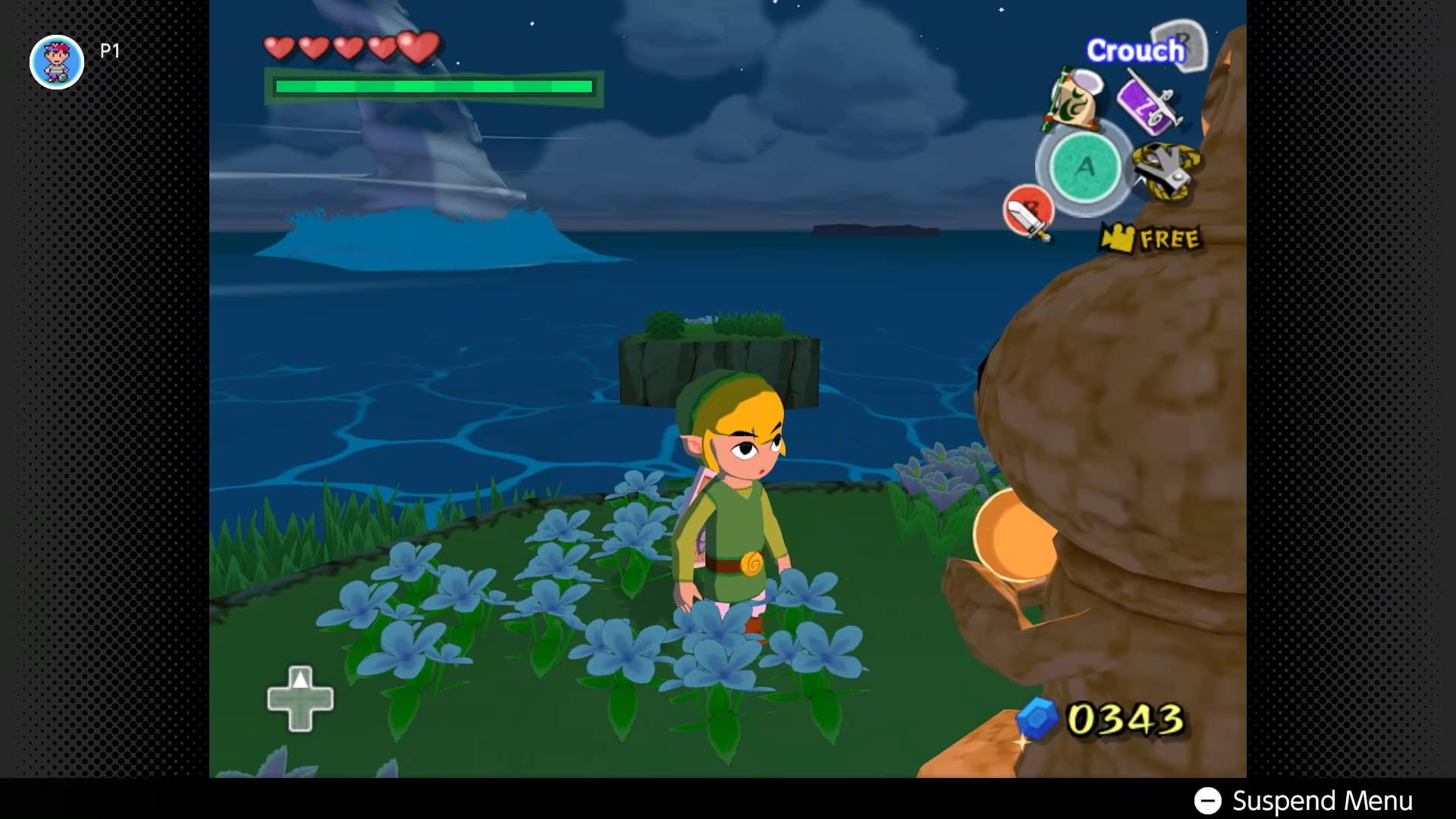
And yet, that very shift to Twilight Princess's realism from declining sales presents an uncomfortable question: was The Wind Waker the right direction for its time? Series creator Shigeru Miyamoto’s alleged “cringe” may well have been prescient: rendering their coolest mascot with the proportions of a Powerpuff Girl signaled a Nintendo at its most myopic, obliviously feeding into fatal stereotypes of being "for kids" much the same as the Gamecube's toy-like design and naming Mario's latest adventure "Super Mario Sunshine".
I don't begrudge myself for loving missteps – far be it from me to judge those who champion the likes of Fire Emblem Engage or Animal Crossing: City Folk, and that Nintendo wanted to avoid another lookalike in a sea of realistic games is commendable. Yet rushed development or not, we're left with a game that doesn’t try hard enough. Defending The Wind Waker is a monumental task, for one's thesis must confess with the caveat that it is plainly unfinished – a burden that even Zelda's lower points in the Wii/DS era can't claim to carry. Make no mistake: The Wind Waker is still a good game, but it cannot be a great one by virtue of its own production.
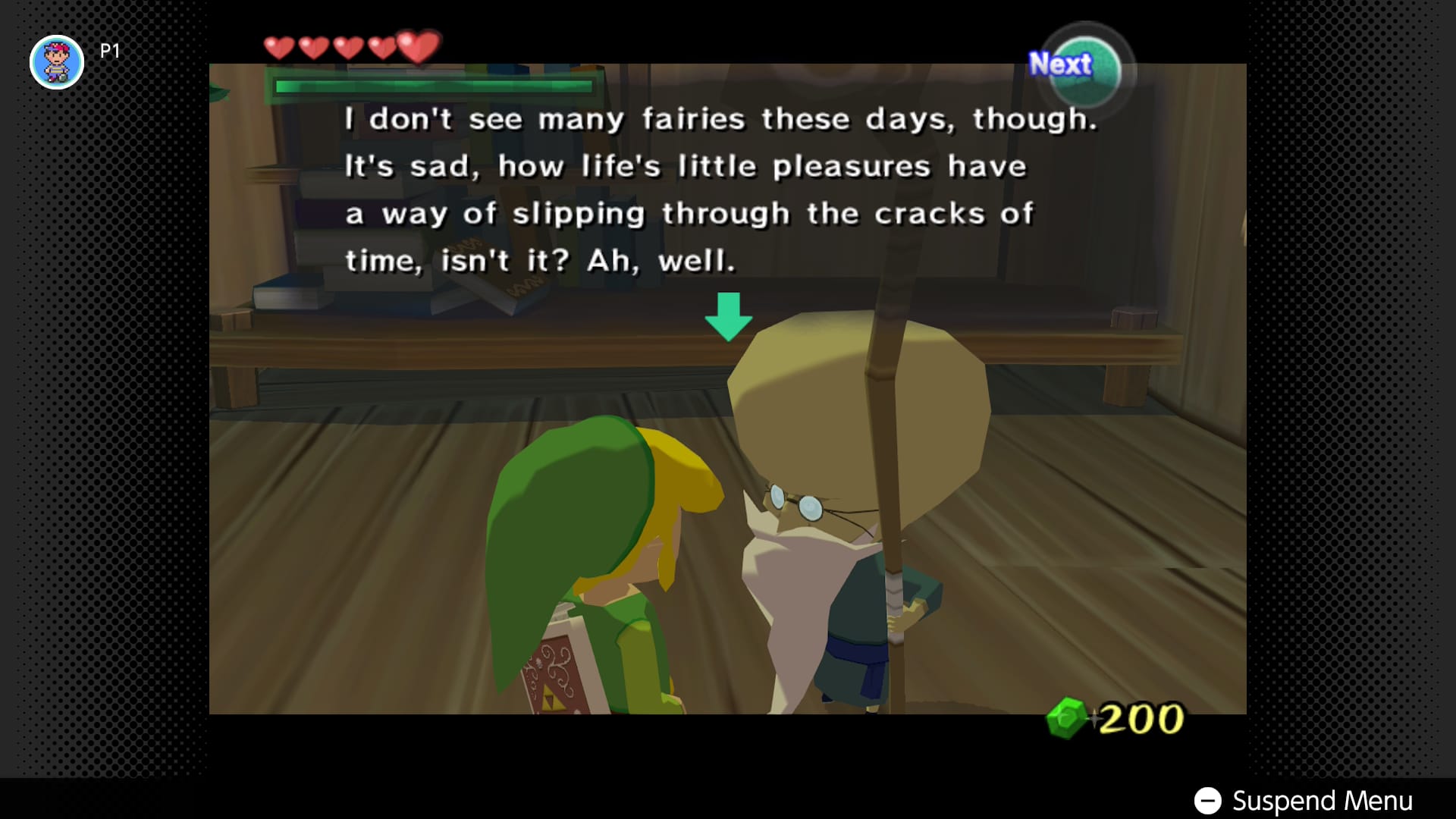
There was a time where I was once Link on that island, restless for adventure every time I’d turn on my GameCube. It was the same period where I'd gorged on gut-busting Homestar Runner cartoons and FLCL reruns entailing abstract coming-of-age stories, yet whereas those continue entertaining and peeling off thematic layers year after year, the waters of The Wind Waker, while still cherished, have only shrunken over time. The fairy dust it sprinkles still charms, but it can scarcely mend a broken heart.
